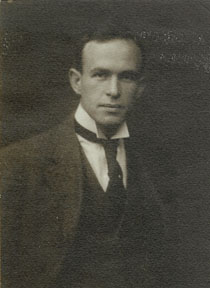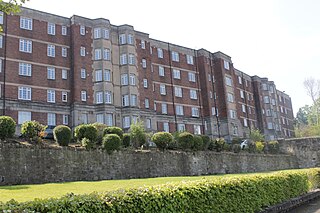Related Research Articles

Charles Rennie Mackintosh was a Scottish architect, designer, water colourist and artist. His artistic approach had much in common with European Symbolism. His work, alongside that of his wife Margaret Macdonald, was influential on European design movements such as Art Nouveau and Secessionism and praised by great modernists such as Josef Hoffmann. Mackintosh was born in Glasgow and died in London. He is among the most important figures of Modern Style.

Hideo Sasaki was a Japanese American landscape architect.

Thomas Leverton Donaldson was a British architect, notable as a pioneer in architectural education, as a co-founder and President of the Royal Institute of British Architects and a winner of the RIBA Royal Gold Medal.

Sir John James Burnet was a Scottish Edwardian architect who was noted for a number of prominent buildings in Glasgow and London. He was the son of the architect John Burnet, and later went into partnership with his father, joining an architectural firm which would become an influential force in British Modern architecture in the 20th century.

John Gaw Meem IV was an American architect based in Santa Fe, New Mexico. He is best known for his instrumental role in the development and popularization of the Pueblo Revival Style and as a proponent of architectural Regionalism in the face of international modernism. Meem is regarded as one of the most important and influential architects to have worked in New Mexico.
David MacGibbon and Thomas Ross were Scottish architects. Their practice, MacGibbon and Ross was established in 1872 and continued until 1914. They are best known today for their comprehensive published surveys of Scotland's architectural heritage.
James Marjoribanks MacLaren was a Scottish architect associated with the Arts and Crafts movement and the development of Scottish Vernacular architecture. He was a major influence on Charles Rennie Mackintosh, and designed buildings in London, the Canary Islands, Stirling and Fortingall in Perthshire.

Jules Jacques Benois Benedict was one of the most prominent architects in Colorado history, whose works include a number of well-known landmarks and buildings listed on the National Register of Historic Places.

Eugene Sternberg was a Hungarian-born American architect known for his passionate commitment and contribution to contemporary/modernist architecture and town planning in Colorado and other Rocky Mountain states between 1950 and 1990. He designed over 400 building projects and subdivisions, many of them iconic examples of Modernist architecture. Since his focus was on improving the quality of life of the general population, the structures he built were beautiful, useful, and cost-effective. Most of his projects were in the category of social architecture: affordable homes, senior housing projects, public housing, hospitals, medical clinics, public schools, community colleges, community centers, churches, buildings for credit unions, labor unions, and headquarters offices for Rural Electric Associations. As a planner Sternberg designed a number of innovative housing subdivisions and master plans for college campuses, governmental complexes, county fairgrounds, and a number of small western cities.

Fentress Architects is an international design firm known for large-scale public architecture such as airports, museums, university buildings, convention centers, laboratories, and high-rise office towers. Some of the buildings for which the firm is best known include Denver International Airport (1995), the modernized Tom Bradley International Terminal at LAX (2013), the National Museum of the Marine Corps near Quantico, Virginia (2005), and the Green Square Complex in Raleigh, North Carolina (2012).

Alan B. Ford, FAIA, is an American architect and author best known for his work on K-12 sustainable schools.

The architecture of Scotland includes all human building within the modern borders of Scotland, from the Neolithic era to the present day. The earliest surviving houses go back around 9500 years, and the first villages 6000 years: Skara Brae on the Mainland of Orkney being the earliest preserved example in Europe. Crannogs, roundhouses, each built on an artificial island, date from the Bronze Age and stone buildings called Atlantic roundhouses and larger earthwork hill forts from the Iron Age. The arrival of the Romans from about 71 AD led to the creation of forts like that at Trimontium, and a continuous fortification between the Firth of Forth and the Firth of Clyde known as the Antonine Wall, built in the second century AD. Beyond Roman influence, there is evidence of wheelhouses and underground souterrains. After the departure of the Romans there were a series of nucleated hill forts, often utilising major geographical features, as at Dunadd and Dunbarton.
Charles Allan Haertling was an American architect, whose works often combined elements of modernism and organic architecture. He is best known for his distinctive residential projects in and around Boulder and Denver, Colorado.

Allen Tupper True was an American illustrator, easel painter and muralist who specialized in depicting the American West.

Sir Caspar Purdon Clarke was an English architect and museum director.

Thomas Pellatt Barber was an architect active in the Southwestern United States. Several of his works are listed on the U.S. National Register of Historic Places.

Mary E. Miller (1843–1921) settled in the Territory of Colorado in 1863 with her husband, Lafayette Miller. After her husband died, she founded the town of Lafayette, Colorado, named for her husband. Miller was called the "Mother of Lafayette. She was the first woman bank president in the United States, a philanthropist and an astute businesswoman.

Robert Burns Dick (1868–1954) was a British architect, city planner and artist. Mainly working in the Newcastle upon Tyne area, he designed municipal buildings, churches and over one hundred houses and housing schemes in the North East of England.

Stewart Kaye FRIBA FRICS (1885–1952) was a Scottish architect in the 20th century. Working in a stripped down Scottish version of the Art Deco style he was consultant architect to the Presbytery of East Lothian and the Halifax Building Society. Mainly based in Edinburgh he is responsible for a large proportion of the city's housing estates from the 1930s.